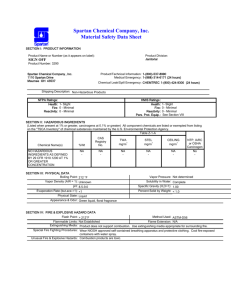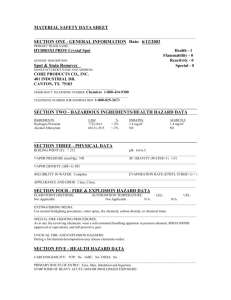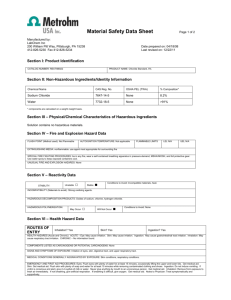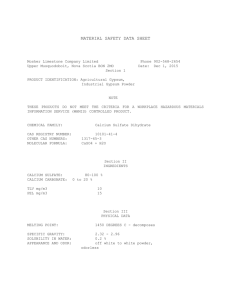TOXIC CHEMICALS EMITTED BY DRYER SHEETS
advertisement
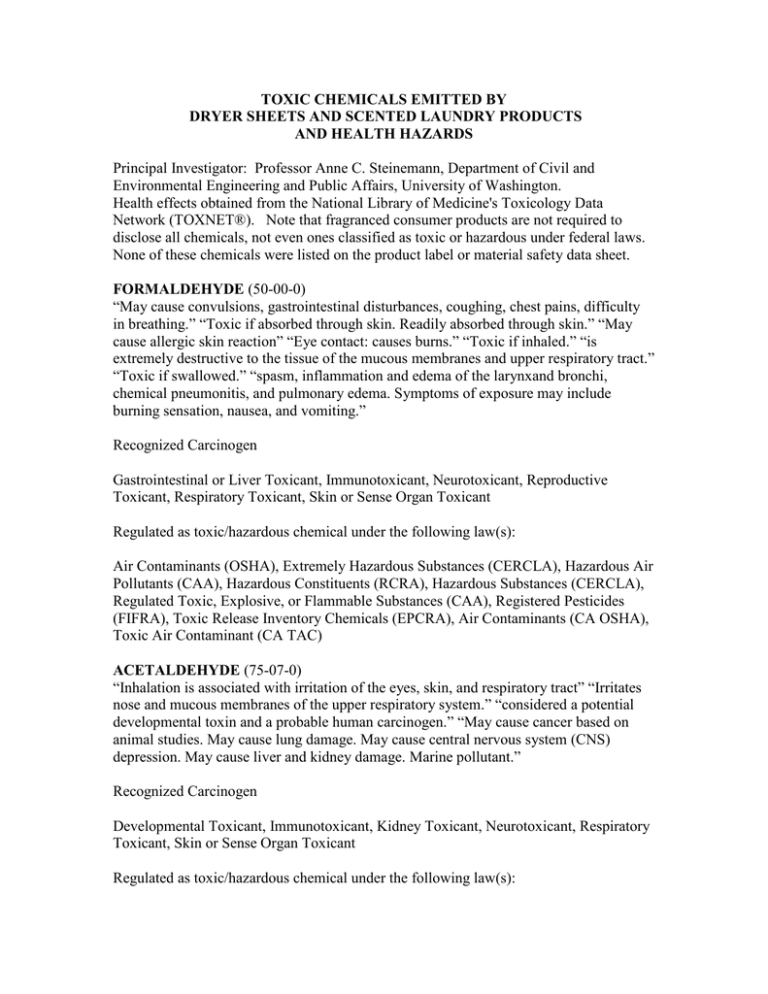
TOXIC CHEMICALS EMITTED BY DRYER SHEETS AND SCENTED LAUNDRY PRODUCTS AND HEALTH HAZARDS Principal Investigator: Professor Anne C. Steinemann, Department of Civil and Environmental Engineering and Public Affairs, University of Washington. Health effects obtained from the National Library of Medicine's Toxicology Data Network (TOXNET®). Note that fragranced consumer products are not required to disclose all chemicals, not even ones classified as toxic or hazardous under federal laws. None of these chemicals were listed on the product label or material safety data sheet. FORMALDEHYDE (50-00-0) “May cause convulsions, gastrointestinal disturbances, coughing, chest pains, difficulty in breathing.” “Toxic if absorbed through skin. Readily absorbed through skin.” “May cause allergic skin reaction” “Eye contact: causes burns.” “Toxic if inhaled.” “is extremely destructive to the tissue of the mucous membranes and upper respiratory tract.” “Toxic if swallowed.” “spasm, inflammation and edema of the larynxand bronchi, chemical pneumonitis, and pulmonary edema. Symptoms of exposure may include burning sensation, nausea, and vomiting.” Recognized Carcinogen Gastrointestinal or Liver Toxicant, Immunotoxicant, Neurotoxicant, Reproductive Toxicant, Respiratory Toxicant, Skin or Sense Organ Toxicant Regulated as toxic/hazardous chemical under the following law(s): Air Contaminants (OSHA), Extremely Hazardous Substances (CERCLA), Hazardous Air Pollutants (CAA), Hazardous Constituents (RCRA), Hazardous Substances (CERCLA), Regulated Toxic, Explosive, or Flammable Substances (CAA), Registered Pesticides (FIFRA), Toxic Release Inventory Chemicals (EPCRA), Air Contaminants (CA OSHA), Toxic Air Contaminant (CA TAC) ACETALDEHYDE (75-07-0) “Inhalation is associated with irritation of the eyes, skin, and respiratory tract” “Irritates nose and mucous membranes of the upper respiratory system.” “considered a potential developmental toxin and a probable human carcinogen.” “May cause cancer based on animal studies. May cause lung damage. May cause central nervous system (CNS) depression. May cause liver and kidney damage. Marine pollutant.” Recognized Carcinogen Developmental Toxicant, Immunotoxicant, Kidney Toxicant, Neurotoxicant, Respiratory Toxicant, Skin or Sense Organ Toxicant Regulated as toxic/hazardous chemical under the following law(s): Air Contaminants (OSHA), Hazardous Air Pollutants (CAA), Hazardous Substances (CERCLA), Regulated Toxic, Explosive, or Flammable Substances (CAA), Toxic Release Inventory Chemicals (EPCRA), Air Contaminants (CA OSHA), Toxic Air Contaminant (CA TAC) ACETONE (67-64-1) “Inhalation: dizziness, breathing difficulties, headaches, loss of coordination, anesthesia and respiratory tract irritation.” “Eyes: irritation, redness, tearing and blurred vision” “slurred speech, drowsiness, and, in severe exposures, coma.” “Acetone vapor can cause central nervous system (CNS) depression.” Cardiovascular or Blood Toxicant, Gastrointestinal or Liver Toxicant, Kidney Toxicant, Neurotoxicant, Respiratory Toxicant, Skin or Sense Organ Toxicant Governing legislation: Air Contaminants (OSHA), Hazardous Substances (CERCLA), Registered Pesticides (FIFRA), Air Contaminants (CA OSHA) BENZYL ACETATE (140-11-4) “toxicity high via inhalation route; capable of causing death or permanent injury” “incapacitating and poisonous” “Hazardous in case of skin contact (irritant), of eye contact (irritant), of ingestion, of inhalation.” “toxic to central nervous system (CNS). Repeated or prolonged exposure to the substance can produce target organs damage.” “Target organ(s): Kidneys. Nerves.” “Mutagenic.” “May affect behavior, brain and central nervous system (general anesthetic), respiration, urinary system.” “From vapors: irritating to eyes and respiratory passages.” “Can be absorbed through the skin causing systemic effects.” “Do not flush to sewer.” Gastrointestinal or Liver Toxicant, Kidney Toxicant, Neurotoxicant, Respiratory Toxicant Regulated as toxic/hazardous chemical under the following law(s): Air Contaminants (CA OSHA) 3-CARENE (13466-78-9) (“BICYCLO(4.1.0)HEPT-3-ENE, 3,7,7-TRIMETHYL-“) “May cause eye irritation.” “Causes skin irritation. May be harmful if absorbed through the skin. May cause sensitization by skin contact.” “May cause irritation of the digestive tract. May be harmful if swallowed.” “May cause respiratory tract irritation. May be harmful if inhaled.” 1,8-CINEOLE (470-82-6) “has caused a transient coma.” “epigastric burning with nausea and usually vomiting, vertigo, ataxia, muscle weakness, stupor, pallor and sometimes cyanosis, respiratory stridor (edema) and miosis.” “May cause skin irritation. May be harmful if absorbed through the skin.” “May cause eye irritation.” “Material may be irritating to mucous membranes and upper respiratory tract. May be harmful if inhaled.” DECANAL (112-31-2) “Harmful by ingestion, inhalation or skin absorption.” “Severe irritant.” “Eyes: may cause severe burns and loss of vision. May cause permanent damage.” “Skin: contact with liquid can cause severe irritation or burns. Readily absorbed through skin.” “extremely irritating or destructive to tissue of the mucous membranes and upper respiratory tract. Symptoms of exposure may include burning sensation, coughing, laryngitis, dyspnea, headache, nausea, and vomiting.” 2,4-DIMETHYL-3-CYCLOHEXENE-1-CARBOXALDEHYDE (68039-49-6) “Irritating to the eyes.” “Irritating to the skin.” “Harmful to aquatic organisms, may cause long-term adverse effects in the aquatic environment.” “may cause irritation of the throat and nose, headache, nausea and drowsiness.” ETHANOL (64-17-5) “May cause irritation of eyes, and mucous membranes.” “May cause central nervous system depression” “Preexisting eye, skin, and respiratory disorders may be aggravated by exposure to this product.” Suspected Carcinogen, Cardiovascular or Blood Toxicant, Developmental Toxicant, Endocrine Toxicant, Gastrointestinal or Liver Toxicant, Kidney Toxicant, Neurotoxicant, Reproductive Toxicant, Respiratory Toxicant, Skin or Sense Organ Toxicant Regulated as toxic/hazardous chemical under the following law(s): Air Contaminants (OSHA), Registered Pesticides (FIFRA), Air Contaminants (CA OSHA) d-LIMONENE (138-86-3) “Extremely hazardous in case of eye contact. Very hazardous in case of skin contact.” “may lead to chronic respiratory irritation.” “Prevent its contact with skin or eyes.” “Always wash thoroughly after using this material and before eating, drinking, ...applying cosmetics. Do not inhale limonene vapor.” “symptoms include...burning pain in the mouth and throat, abdominal pain, nausea, vomiting, diarrhea, transient excitement, ataxia, delirium, stupor, coughing, choking, dyspnea, cyanosis, fever and tachycardia. In addition, pulmonary edema and pneumonitis may occur with limonene aspiration or systemic absorption. Dizziness and suffocation may be observed following limonene inhalation.” LINALOOL (“1,6-OCTADIEN-3-OL, 3,7-DIMETHYL-“) (78-70-6) “Causes central nervous system disorders.” “Contact with the eyes may result in irritation.” “Inhalation may result in respiratory irritation.” “irritating to mucous membranes and upper respiratory tract.” “Causes skin irritation.” Irritant. Mutagenic effects. METHYL BENZOATE (93-58-3) “May cause skin irritation. May be harmful if absorbed through the skin.” “May cause eye irritation.” “May be harmful if inhaled.” “may be irritating to the mucous membranes and upper respiratory tract.” “Harmful if swallowed.” Gastrointestinal or Liver Toxicant, Neurotoxicant, Skin or Sense Organ Toxicant α-PINENE (“2,6,6-TRIMETHYLBICYCLO(3.1.1)-2-HEPT-2-ENE”) (80-56-8) “Irritates skin, mucous membranes.” “Causes skin eruption, GI irritation, delirium, ataxia, kidney damage, coma.” “Inhalation causes palpitation, dizziness, nervous disturbances, chest pain, bronchitis, nephritis.” “Benign skin tumors” “Damaging to the immune system.” Neurotoxicant, Respiratory Toxicant, Skin or Sense Organ Toxicant Governing legislation: Registered Pesticides (FIFRA) ß-PINENE (“2(10)-PINENE”) (127-91-3) “Skin, eye and respiratory irritant.” “very destructive of mucous membranes.” “Vapors may cause dizziness or suffocation.” “Severe irritation.” “Shortness of breath, headache, nausea, and vomiting.” PRENYL ACETATE (1191-16-8) “Skin: causes irritation.” “May be harmful by inhalation, ingestion, or skin absorption.” “Vapor or mist is irritating to the eyes, mucous membranes, and upper respiratory tract.” cis-ROSE OXIDE (16409-43-1) (“4-METHYL-2-(2-METHYL-1-PROPENYL)-TETRAHYDROPYRAN”) “May be irritating to the skin and eyes.” “may cause irritation of the throat and nose, headache, nausea and drowsiness.”

